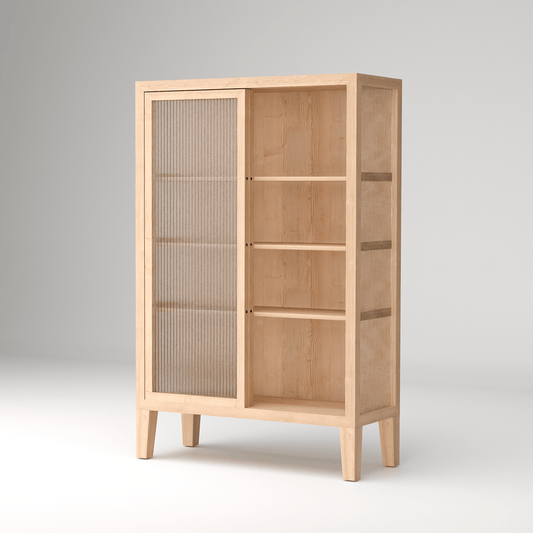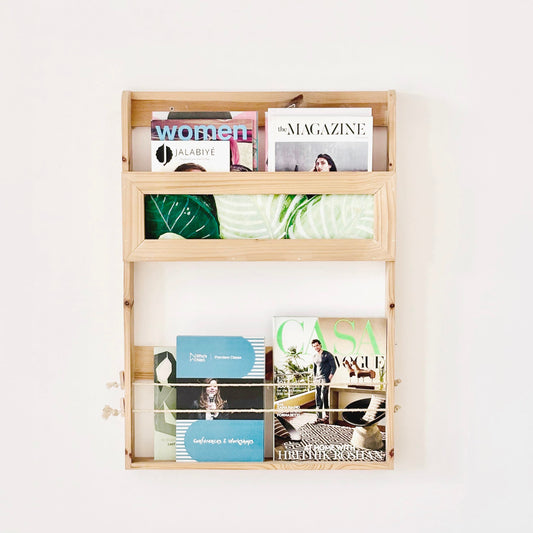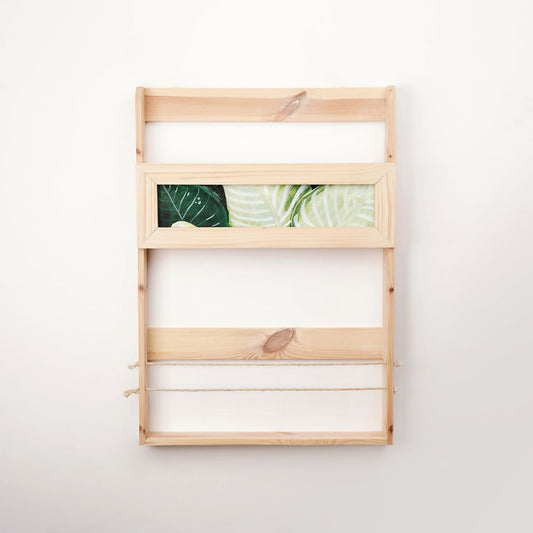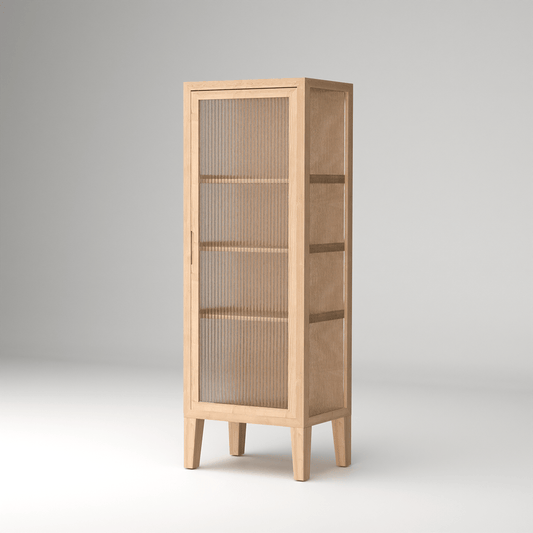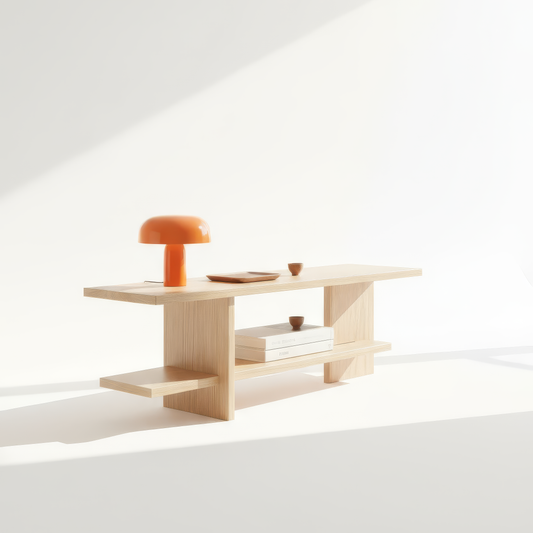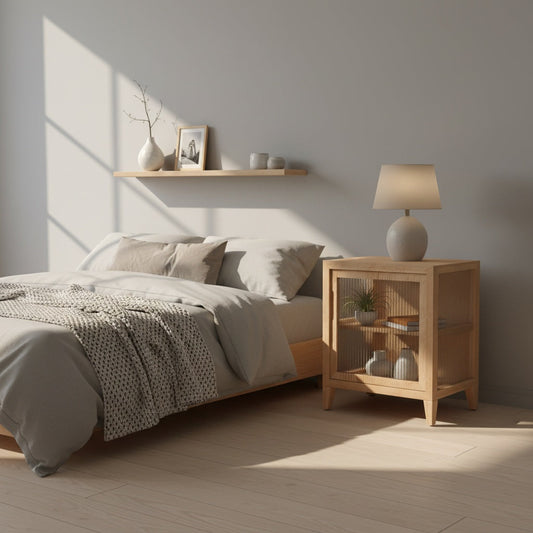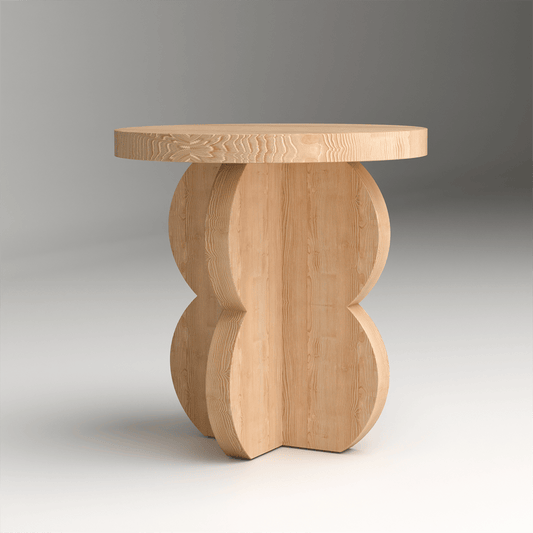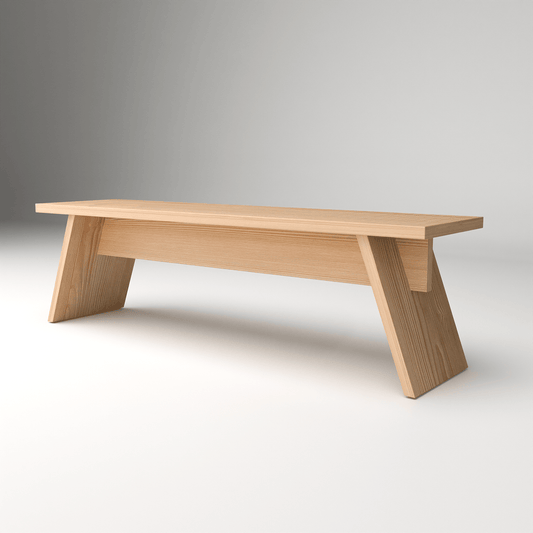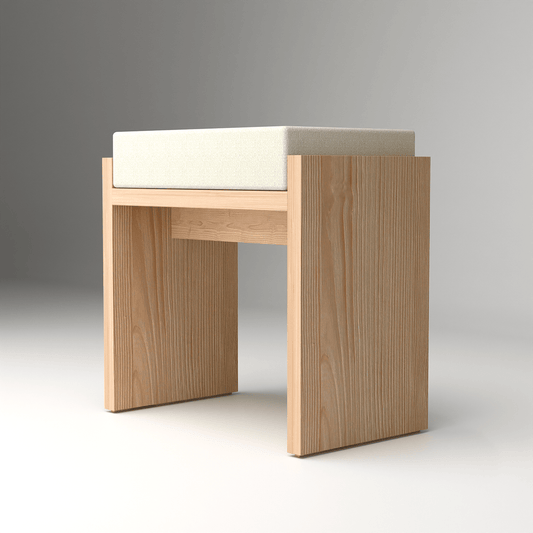Creating a Scandinavian bedroom sanctuary in 2025 means designing a space that prioritizes restorative sleep, emotional well-being, and the kind of deep comfort that supports both physical recovery and mental restoration. This evolution of Nordic bedroom design goes far beyond aesthetic minimalism to embrace a holistic approach that recognizes the bedroom as the most crucial space in our homes for health and happiness.
At A Good Life, we understand that quality sleep is the foundation of a good life. Our handcrafted pine wood bedroom furniture embodies the 2025 Scandinavian approach—combining the visual calm of minimalist design with the warmth and comfort essential for creating truly restorative sleep environments.
The Science of Sleep Sanctuary Design
Modern understanding of sleep science has revolutionized how we approach bedroom design. The 2025 Scandinavian bedroom incorporates evidence-based design principles that actively support better sleep quality and overall well-being.
Sleep-Supporting Design Elements
Circadian Rhythm Support: Design choices that work with natural light cycles to regulate sleep-wake patterns.
Temperature Regulation: Materials and arrangements that promote optimal sleep temperature throughout the night.
Acoustic Comfort: Sound management through material choices and spatial planning that creates peaceful sleep environments.
Air Quality: Natural materials and plants that contribute to healthy indoor air and respiratory comfort.
Stress Reduction: Visual and tactile elements that promote relaxation and reduce anxiety before sleep.
The Psychology of Bedroom Sanctuaries
Research shows that bedroom environments significantly impact:
-
Sleep onset time and quality
-
Stress hormone levels
-
Relationship satisfaction
-
Morning mood and energy
-
Overall life satisfaction and well-being
Foundation Furniture: Building Your Sleep Sanctuary
The foundation of any Scandinavian sleep sanctuary lies in choosing furniture pieces that prioritize both function and the kind of visual calm that promotes rest.
Essential Sleep Sanctuary Furniture
Comfortable Bed Frame: A sturdy, beautiful foundation that supports quality mattresses while contributing to the room's aesthetic appeal.
Bedside Storage: Accessible storage that keeps essentials within reach while maintaining visual calm.
Seating Options: Comfortable seating for putting on shoes, reading, or quiet conversation.
Storage Solutions: Organized storage that keeps the bedroom clutter-free and conducive to rest.
Our Nordic Fluted Glass Cabinet in Pinewood serves as an ideal bedroom storage solution, combining the transparency of fluted glass with the warmth of sustainable pine wood. This piece provides essential storage while maintaining the visual lightness crucial to sleep sanctuary design, allowing you to display meaningful objects while keeping clutter hidden.
Bedside Essentials: Creating Functional Comfort
The bedside area requires special attention in 2025 Scandinavian bedroom design, serving as the transition zone between waking and sleeping states.
Bedside Design Principles
Accessibility: Everything needed for bedtime and morning routines should be within easy reach.
Visual Calm: Bedside areas should promote relaxation rather than stimulation.
Lighting Control: Multiple lighting options for different activities and times of day.
Personal Touch: Space for items that provide comfort and personal connection.
Technology Management: Thoughtful integration of necessary technology without disrupting sleep quality.
Our Minimalist Artsy Nightstand Pinewood Side Table exemplifies perfect bedside design, offering both open and closed storage options while maintaining the clean lines essential to sleep sanctuary aesthetics. The natural pine wood provides visual warmth that makes the bedroom feel welcoming rather than sterile.
Color Psychology for Sleep Sanctuaries
The 2025 approach to bedroom color focuses on psychological impact and sleep quality rather than purely aesthetic considerations.
Sleep-Supporting Color Framework
Calming Neutrals: Soft whites, warm beiges, and gentle grays that promote psychological calm and relaxation.
Nature-Inspired Tones: Muted greens, earth browns, and sky blues that connect the bedroom to natural environments.
Warm Wood Tones: Natural pine and other wood finishes that add warmth without stimulation.
Accent Restraint: Limited use of stronger colors that might be energizing rather than calming.
Color Application for Better Sleep
-
Use cooler colors in areas where temperature regulation is important
-
Incorporate warmer tones through natural materials rather than paint
-
Avoid high-contrast color combinations that might be stimulating
-
Consider how colors look in different lighting conditions throughout the day
-
Allow natural wood tones to serve as the primary color story
Lighting Design for Sleep Quality
Lighting plays the most crucial role in creating bedroom environments that support healthy sleep cycles and morning energy.
Sleep Sanctuary Lighting Strategy
Circadian Support: Lighting that adjusts throughout the day to support natural sleep-wake cycles.
Dimming Capabilities: The ability to gradually reduce light levels as bedtime approaches.
Warm Evening Light: 2200K-2700K lighting that promotes melatonin production and sleepiness.
Task Lighting: Focused light for reading or other bedtime activities that doesn't disturb sleep partners.
Natural Light Control: Window treatments that allow for darkness when needed while maximizing beneficial daylight.
Emergency Lighting: Subtle lighting for nighttime navigation that doesn't disrupt sleep cycles.
Textile Integration for Sleep Comfort
The 2025 Scandinavian bedroom embraces high-quality textiles that contribute to both visual beauty and sleep quality.
Sleep-Supporting Textile Choices
Natural Fiber Bedding: Linen, cotton, and wool bedding that regulates temperature and feels wonderful against the skin.
Layered Comfort: Multiple textile layers that can be adjusted for seasonal and personal comfort needs.
Hypoallergenic Materials: Natural materials that support rather than compromise respiratory health.
Easy Care: Textiles that can be easily maintained to support bedroom hygiene and freshness.
Seasonal Adaptability: Bedding and textiles that can be changed to respond to seasonal comfort needs.
Storage Solutions for Bedroom Serenity
Maintaining the calm atmosphere essential to sleep sanctuaries requires thoughtful storage solutions that keep personal items organized and accessible.
Sleep Sanctuary Storage Principles
Hidden Organization: Storage that maintains visual calm while providing practical organization for clothing and personal items.
Bedside Accessibility: Easy access to items needed for bedtime and morning routines.
Clothing Care: Storage solutions that keep clothing organized and in good condition.
Seasonal Rotation: Systems that accommodate seasonal clothing changes without creating clutter.
Personal Items: Secure, organized storage for jewelry, documents, and other personal belongings.
Air Quality and Natural Elements
Creating healthy bedroom environments requires attention to air quality and biophilic design elements that support respiratory health and psychological well-being.
Bedroom Air Quality Elements
Natural Materials: Wood, cotton, linen, and other materials that don't off-gas harmful chemicals.
Plant Integration: Carefully chosen plants that improve air quality without creating allergens or maintenance burdens.
Ventilation: Adequate air circulation that maintains freshness without creating drafts.
Humidity Control: Materials and systems that help maintain optimal humidity levels for sleep comfort.
Chemical Avoidance: Avoiding synthetic materials and finishes that might impact air quality or sleep.
Technology Integration for Sleep Wellness
Modern bedrooms must thoughtfully integrate necessary technology while maintaining the calm atmosphere essential to quality sleep.
Sleep-Compatible Technology
Charging Solutions: Built-in charging that eliminates bedside cable clutter while keeping devices accessible.
Smart Climate: Automated temperature and humidity control that maintains optimal sleep conditions.
Sound Management: White noise systems or sound masking that creates consistent, peaceful audio environments.
Light Automation: Smart lighting that gradually adjusts throughout the evening and morning to support circadian rhythms.
Sleep Tracking: Unobtrusive monitoring that provides insights without creating bedroom clutter or distraction.
For bedroom organization that supports both technology needs and sleep sanctuary principles, consider our Minimalist Floating Bedside Table in Pinewood. This wall-mounted piece provides essential bedside storage while maintaining floor space and visual lightness, creating the clean, uncluttered environment crucial to restorative sleep.
Creating Intimate Connection
Bedrooms serve not just individual sleep needs but also relationship intimacy and connection. The 2025 Scandinavian approach considers both individual and shared needs.
Relationship-Supporting Design
Shared Comfort: Furniture and arrangements that serve both partners' needs and preferences.
Individual Space: Personal areas within shared bedrooms that allow for individual expression and needs.
Communication Areas: Seating or arrangements that facilitate conversation and connection.
Privacy Options: Design elements that can create privacy when needed within shared spaces.
Aesthetic Harmony: Choices that reflect both partners' preferences and create unified, peaceful environments.
Seasonal Bedroom Adaptations
Sleep needs change with seasons, and 2025 Scandinavian bedrooms are designed to adapt to these changing requirements.
Seasonal Sleep Sanctuary Elements
Winter Warmth: Heavier textiles, warmer lighting, and elements that create psychological warmth during darker months.
Spring Renewal: Lighter textiles, increased natural light, and fresh elements that reflect seasonal energy.
Summer Cooling: Minimal textiles, maximized ventilation, and elements that create cooling psychological effects.
Autumn Preparation: Gradual introduction of warmer, more substantial elements as daylight decreases and temperatures drop.
Maintenance for Sleep Quality
Maintaining bedroom environments that consistently support quality sleep requires ongoing attention to cleanliness, organization, and atmosphere.
Sleep Sanctuary Maintenance
Regular Cleaning: Consistent cleaning schedules that maintain air quality and visual calm.
Textile Care: Proper care of bedding and textiles to maintain comfort and hygiene.
Decluttering: Regular removal of items that don't contribute to sleep quality or bedroom serenity.
Air Quality: Attention to ventilation, plant care, and material maintenance that supports healthy indoor air.
Seasonal Updates: Changes in textiles, lighting, and arrangements to maintain optimal comfort throughout the year.
Budget-Friendly Sleep Sanctuary Creation
Creating effective sleep sanctuaries doesn't require expensive overhauls or luxury purchases.
Affordable Sleep Sanctuary Strategies
Lighting Focus: Warm-bulb lamps, candles, and blackout solutions can immediately improve sleep quality.
Textile Investment: Quality bedding has immediate impact on sleep comfort and bedroom atmosphere.
Decluttering: Often the most impactful improvement costs nothing but time and decision-making.
Plant Addition: Affordable air-purifying plants can improve both air quality and bedroom atmosphere.
Arrangement Optimization: Repositioning existing furniture can create more sleep-friendly environments.
The Future of Sleep Sanctuary Design
Looking beyond 2025, bedroom design will likely continue evolving to address changing sleep research and lifestyle needs.
Emerging Sleep Sanctuary Trends
Personalized Environments: Bedrooms that automatically adjust to individual sleep patterns and preferences.
Health Integration: Design that actively monitors and supports various aspects of physical and mental health.
Climate Adaptation: Bedroom design that responds to changing environmental conditions and seasonal patterns.
Wellness Technology: Advanced integration of health-supporting technology within beautiful, calm aesthetics.
Biophilic Expansion: Deeper integration of natural elements and patterns that support circadian rhythms and psychological well-being.
Creating a Scandinavian sleep sanctuary in 2025 means embracing a holistic approach that considers not just how the bedroom looks, but how it supports your most fundamental need for restorative sleep. By focusing on natural materials, thoughtful lighting, comfortable storage, and air quality, you can create a bedroom that truly serves as a foundation for health and happiness.
The key to successful sleep sanctuary design lies in understanding that quality sleep is not a luxury but a necessity, and that our bedroom environments play a crucial role in supporting this essential human need. As Scandinavian design continues to evolve, this sleep-centered approach will remain one of its most important contributions to creating spaces that truly support the good life.


